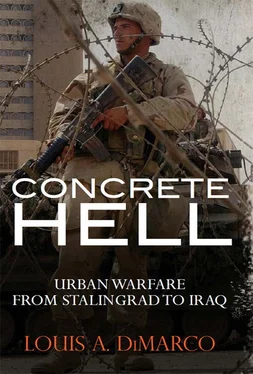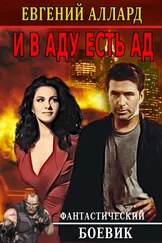CHAPTER 4
URBAN WARFARE FROM THE SEA
Inchon and Seoul, 1950
After World War II the American military jettisoned the vast bulk of the superb ground force that had fought and won the war. By 1950 that force was a hollow shell of its former self. The only remaining remnants of the combat-experienced ground forces were the non-commissioned officer and officer leadership of the skeleton divisions that remained in the force. The bulk of the force in 1950 was draftees with no experience, and in some cases their equipment wasn’t even the best of the World War II equipment. In the late summer of 1950, this force found itself in the midst of another large-scale urban battle against a wholly unanticipated foe in a theater of operations that many Americans had never heard of and would have a hard time finding on a map.
In June 1950 the forces of Communist North Korea launched a surprise attack on the forces of South Korea. The military forces of the North, well trained and equipped by the Soviet Union, vastly outnumbered those of the South. In addition, though there were US Army advisors with the Republic of Korea’s (ROK) military, the US vision for the ROK Army (ROKA) was as a large military police force; which meant that there were no heavy weapons, tanks, heavy artillery or antitank weapons among the small South Korean force. Because of this, and the surprise of the attack, the North Korea People’s Army (KPA) was very successful, and in just six weeks managed to push the combined South Korean and American defenders back to a small perimeter at the toe of Korea around the important port city of Pusan.
At the end of the first week of the surprise attack, the US military entered the war decisively on the side of South Korea. The most effective and responsive weapon that the US had in Asia was the US Air Force, and air attacks against the advancing North Korean columns began on June 27. However, air attacks could slow, but not stop the North Korean advance. Therefore, the US Eighth Army, stationed in Japan, began to deploy to Korea. The problem was that the Eighth Army in 1950 was a shadow of the great American army that had fought its way across the Pacific Ocean under General Douglas MacArthur during World War II. Still under MacArthur’s command — MacArthur was the Supreme Commander Allied Powers in Japan, and Commander US Forces Far East — the Eighth Army was greatly debilitated by post-World War II defense cuts. The Eighth Army had four divisions organized into two corps. However, each of the army’s infantry divisions comprised only two regiments instead of the doctrinal three. Likewise, each regiment had only two battalions, and each battalion only two companies. Similarly, division artillery was reduced to two battalions, all the medium and heavy artillery had been removed from the force at all levels, and each battalion only had two firing batteries of light howitzers. The medium-tank battalions supporting each infantry division was similarly reduced to light-tank battalions of only two companies each. Finally, if the numbers alone were not bad enough, budget and facility constraints greatly inhibited training, leaving the units in a poor state of readiness. Though a formidable force on paper, the Eighth Army and all its subordinate forces were in reality only about 50 percent as capable as the World War II version of the army. This army was thrown as fast as possible into the path of the advancing North Koreans.
General Walton Walker commanded the combined US and South Korean armies on the peninsula. In the last weeks of August 1950 he managed to stem the North Korean onslaught around the city of Pusan. However, in the first eight weeks of the war the Communists captured over 80 percent of the land of South Korea. Clearly, Walker and his commander, General Douglas MacArthur, could not sit passively on the defensive. As early as the end of July, as Walker fought desperately to maintain a toehold in Korea, General MacArthur was thinking in terms of a counterstroke.
MacArthur, in keeping with the operational thinking he had developed during the Pacific campaign of World War II, was keen to avoid the hard campaign that a counterattack back up the mountainous Korean peninsula would entail. He set his staff to investigating the various possibilities of an amphibious operation to bypass the major North Korean forces and land in their rear. This would avoid the tremendous casualties of a frontal assault, save invaluable time, and guarantee the complete destruction of the bulk of the North Korean army. The only problem was there was no suitable landing site for a major amphibious thrust along Korea’s very formidable coastline. The closest that the planners could identify was the city of Inchon on Korea’s west coast.
The command faced several significant problems executing a major amphibious assault at Inchon. These included the difficulty of the local tides, lack of suitable beaches, the difficulty of achieving surprise, and a shortage of trained troops available. MacArthur carefully considered the problems but also weighed the points in Inchon’s favor. The difficulty of the operation would lend itself to surprise and thus lessen opposition to the landing. Inchon’s geographic position put it close to Seoul. Thus, a successful landing at Inchon could easily lead to a quick conquest of Seoul. Seoul was MacArthur’s ultimate objective. The city’s geographic location put it astride the only important north–south maneuver corridor on the peninsula. Control of Seoul meant control of South Korea. More important than its position, which was extremely important, was that Seoul was also the capital city of South Korea. To many, the loss of Seoul had represented losing the war in the first week: recapturing Seoul represented snatching victory from apparent defeat. MacArthur recognized that the political and psychological importance of Seoul were beyond measure. MacArthur understood that the value of Seoul outweighed the operational risks inherent in an amphibious assault and therefore determined that the operation proceed over the objections of key subordinates and experts on amphibious operations.
To execute the operation to capture Seoul the Americans assembled a new unit, separate from the US Eighth Army fighting the battle at Pusan. This new unit, X Corps, was tailored for the amphibious operation, and reported not to Eighth Army, but directly to General MacArthur’s Far East Command. The two major subcomponents of the X Corps were the 1st US Marine Division, and the US Army 7th Infantry Division, all under the X Corps commander, Major General Edward Almond. In addition to the two infantry divisions, the corps had the direct support of the Marine Air Wing of the 1st Marine Division. It also included two ROK military units: the ROK Marine Regiment attached to the 1st Marine Division, and the ROK 1st Infantry Regiment attached to the 7th Infantry Division. These latter two units were critical for a variety of reasons, not the least of which was to improve the flagging prestige and morale of the ROK military, and also to highlight the important political objectives which were an important goal of the operation.
Map 4.1 The Inchon Landings, September 1950
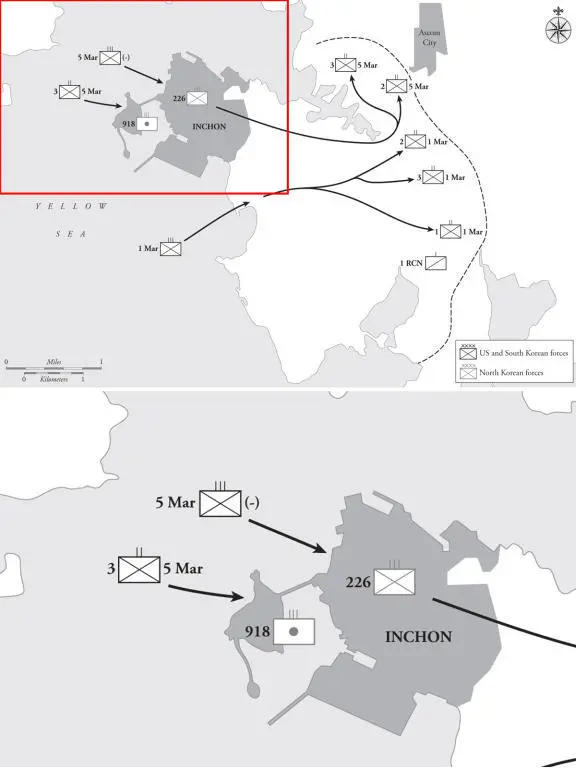

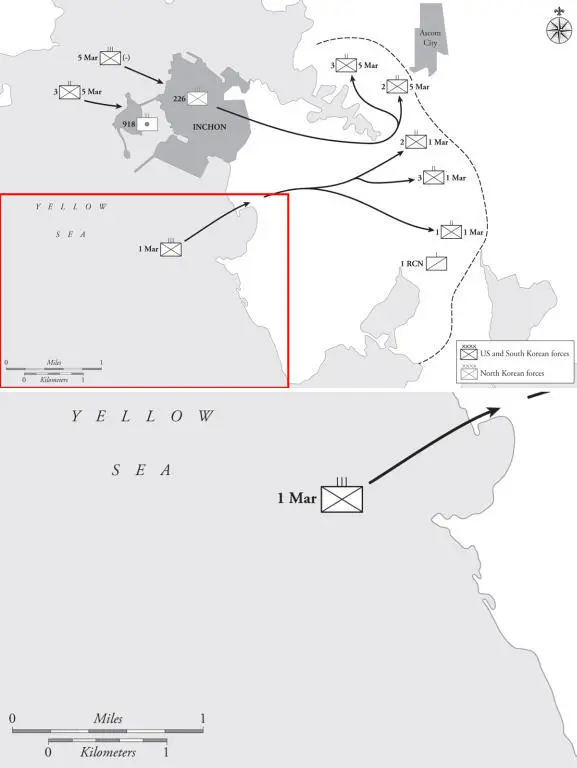
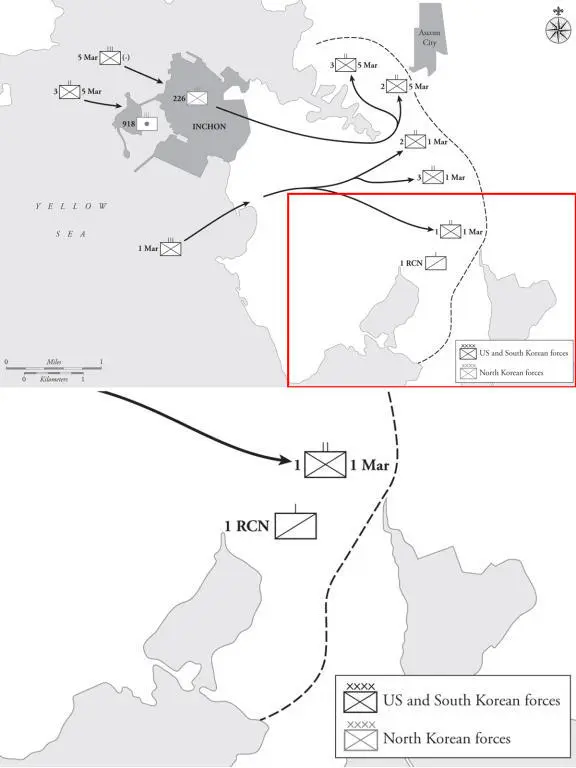
Seoul was a city of over a million people when the war broke out — the fifth largest urban population in Asia. It was the ancient capital of the Korean peninsula and thus was extremely important to both North Korea (the Democratic People’s Republic of Korea — DPRK) and to South Korea. As the North Korean forces poured across the border in the summer of 1950, the population had panicked and attempted to flee. However, over a million people — largely without automotive transportation — cannot quickly pick up and move. So, as the Americans began to execute operations to recapture the capital, there were hundreds of thousands of South Korean civilians still living in Seoul under the occupation rule of North Korea.
Читать дальше
